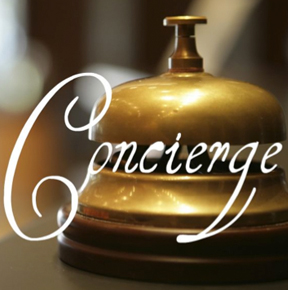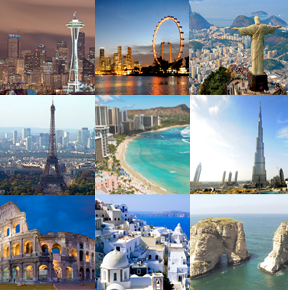A Grand Tour of South America is an amazing journey by any standard. Add your own luxury private jet and it becomes the trip of a lifetime. Without crowded airports, plane changes, and bumpy trips over land to get to remote destinations, you’ll see more and do more than you ever thought possible on a 13-day South American trip. After all, time is the ultimate luxury.
Tailored luxury travel experience that pulls out all the stops. From the mysterious moai of Easter Island to the grand scope of Machu Picchu, from the otherworldly Atacama Desert to the lush Worldwide Travel Experience spectacle of Iguazu Falls to the nonstop celebration that is Rio de Janeiro, you’ll be astounded and amazed at every turn. If there is one trip that is worth every penny, this is it.
Included:
- Charter air travel for travel between Lima and Cusco onboard a BAE 146 jet
- Private jet travel, onboard an Airbus A319 VIP, for all other internal flights as per the itinerary
- Services of professional Tour Director throughout the itinerary, along with local guides in select locations
- Best-in-the-region accommodations
- All meals included in the itinerary
- Complimentary local beer, wine and soft drinks served with included lunches and dinners
- All gratuities
Trip Highlights
- See Machu Picchu at sunrise
- Enjoy cocktails in the shadow of the moai on Easter Island
- Bicycle from the Atacama Salt Flat to Cejar Lagoon for an unforgettable sunset
- Feel the mist on your face as you stand at the edge of Iguazu Falls
- Look down at all of Rio from the top of Sugar Loaf Mountain
- Travel like royalty in a private jet with all first class seats
Not Included:
- International airfare to and from the destination, please contact us for the best available prices from your home city.
- Travel Insurance is not included, but available, please contact us for the best options for your family.
- Meals and drinks not mentioned in the itinerary below.
- Tours not mentioned in the itinerary below.
- Gratuities (optional).
Your Jet : Airbus A319 VIP
The Airbus A319 is designed for long-range group travel, suitable for dignitaries and diplomats, entertainment tours and sports teams, and our members. It includes three separate cabins and a private lounge. Leather first-class seats recline flat for naps and overnight journeys and all feature premium entertainment consoles and power ports for personal electronic devices. You’ll have a dedicated flight staff and gourmet meals in-flight. Once you fly on this jet, you’ll have a hard time going back to commercial air travel.
Itinerary & Highlights Accommodations & Details
There are two itineraries available for this journey, one traveling from west to east (from Lima to Rio de Janeiro), and a second traveling from east to west (Rio de Janeiro to Lima). Both include identical itinerary stops, excursions and experiences, just in reverse order. For the purposes of this guide, we are highlighting the Lima to Rio de Janeiro itinerary.
Day 1 – Lima, Peru
Lima is your gateway to South America on this trip and your first stop on the way to the Peruvian high country. You’ll head straight to the coast where your hotel awaits and you can rest up from your long trip.
Days 2 — 4 – Cusco And Machu Picchu
From Lima, you’ll travel back thousands of years to the time of the Incas when you arrive in Cusco, the heart of the Inca Empire and the oldest continuously inhabited city in the Western Hemisphere. Tucked into southeastern Peru near the Urubamba Valley of the Andes, Cusco is a UNESCO World Heritage Site filled with fascinating architecture dating the pre-Columbian era through colonial times and the baroque era. Cusco is also the gateway to Machu Picchu, the “Lost City” of the Inca Empire, high up in a tropical mountain forest.
The Cradle of Western Civilization
After a wake-up coffee and tea reception to start your morning and introduce you to your group, you’ll head to the airport to board your charter plane for Cusco. When you arrive, you’ll get a full tour of the city, including the San Domingo convent, the history-rich main square, and the Renaissance-style Cusco Cathedral. When your tour is finished, you’ll enjoy a private lunch at El Huerta. Food is prepared Pachamanca-style, a traditional Andean technique where meat and produce are cooked using an under-earth baking process. A Shaman will officially welcome you to Cusco and Peru with an Andean ritual.
Dinner that evening is a gala affair at the Convent of San Francisco, a 17th century convent church known for its huge collection of colonial artwork. You’ll get a guided tour of the paintings and tapestries from the director of the museum, and be entertained by traditional Kena flute music as you enjoy the festivities.
Machu Picchu—the luxury route
You’ll travel from Cusco to Machu Picchu in grand style aboard the Hiram Bingham Luxury Train. You’ll enjoy gourmet brunch on board and unbelievable mountain scenery, and a few hours and another short shuttle ride later, you’ll step out into the remarkable world of Machu Picchu. You’ll be arriving as most tourists are leaving, so you’ll get a small-group guided tour of the Inca citadel that makes you feel like you’re the only ones there. Your hotel is only steps away from the citadel, and you’ll enjoy afternoon tea and a fine dinner surrounded by lush beauty and local stone and wood décor.
Rising with the mountain mist
We know not everyone is a morning person. Nonetheless, we highly recommend that you wake up with the sunrise for a glorious hike of Machu Picchu before the first crowds arrive. You will not regret it, and you’ll have your choice of two hikes. You can trek to the Inti Punku, or famous Sun Gate, which is the entry point to Machu Picchu on the Inca Trail and offers excellent views of the ruins. Or, you can climb up the Huayna Picchu, the highest peak inside the ancient city, where you will be rewarded with excellent views of the surrounding area, as well as a unique view of Machu Picchu below. After your hike, relax back at the lodge or continue exploring the ruins with a guide.
After lunch at the Sanctuary Lodge, you’ll take the early evening Hiram Bingham train back to Cusco for the night, enjoying a gourmet dinner en route.
Days 5 — 7 – Easter Island
There may not be a more intriguing and mysterious place on earth than Easter Island, with its isolated location and silent stone figures that stand as monuments to the ancient, industrious Rapa Nui society. The seafaring skills that brought the Rapa Nui to this remote outpost and the effort that went into constructing the large moai statues (which average 13 feet tall and 14 tons apiece) are astonishing feats and still much of a mystery. Why did the Rapa Nui people undertake the gargantuan project? And how did the society virtually vanish hundreds of years after the first settlers appeared? Scholars continue to unravel the answers today, but the ancient civilization and the moai they left behind continue to intrigue visitors today.
Fun Fact: The mystery of the sweet potato
Where did the first Easter Island inhabitants originate? The commonly accepted theory is that they made their way to the island from the Marquesas Islands via canoe somewhere between 400 and 800 A.D. However, the possibility that early inhabitants brought sweet potato with them to plant on the island cast some doubts on their Polynesian roots. According to botanists, sweet potato originally came from South America. Did the first residents come from the other direction?
That was author and adventurer Thor Heyerdahl’s theory. According to Heyerdahl, pre-Inca people could have sailed to the island from Peru, taking advantage of westerly trade winds made even stronger by an El Nino year. Heyerdahl himself proved the theory’s plausibility by drifting on the balsa raft Kon Tiki for three months and 4,300 nautical miles until he ran aground near the Polynesian island of Puka Puka. However, archaeologists maintain that archaeological, linguistic, and biological data irrefutably point to Polynesian roots, as does DNA from 12 Easter Island skeletons.
So what’s with the sweet potato? It’s possible that the early Polynesian explorers made a detour to South America before doubling back to Easter Island. Or, ancient Peruvian explorers could have visited the island and brought the sweet potato with them. Whatever happened, it’s undisputed that the sweet potato was the cornerstone of island nutrition, providing the fuel and energy needed to build a civilization, not to mention all those moai.
Mingling with the Moai
After taking a charter flight back from Cusco to Lima, you’ll board your private jet for the flight over the Pacific to Easter Island. The trip takes nearly six hours, but you’ll have plenty of room to stretch out and relax during your flight. When you touch down at Easter Island, you’ll go directly to Ahu Tahai, one of the oldest Rapa Nui sites on the island. Enjoy cocktails at sunset in the shadow of five moai, some restored with their original coral eyes.
Ancient and modern Easter Island
The following day, you’ll immerse yourself deeper in the culture and history of the Rapa Nui at the Sebastian Englert Anthropological Museum. You’ll see the only female moai and one of the original coral eyes that were placed in the first moai. The museum also houses wood statuettes, a photographic collection, archives of traditional music, and a three-thousand-volume library. After the museum, you’ll tour the island’s village, visiting Te Pito O Te Henua, a huge round rock representing the “world navel,” the handicraft market, the Catholic church, the commercial center, and Hanga Roa and Hanga Pika bays.
In the afternoon, sample some of the outdoor activities that the island has to offer, including snorkeling and diving, horseback riding, biking or trekking to one of the island’s volcanoes, hiking one of the trails used to transport the moai to their sites, walking to the island caves, or boating or fishing off the coast.
Cave paintings, volcanoes, and a ceremonial village
On your last day on Easter Island, you’ll explore Ana Kai Tangata, a beautiful cave with ancient paintings on the rock wall. Then you’ll proceed up to Rano Kau, a volcano whose crater is almost a mile across and contains a tranquil freshwater lagoon. Finally, you’ll visit the ceremonial village of Orongo near the volcano, where the Rapa Nui gathered each year to select the island’s religious leader. Regroup and relax with lunch and cocktails on Anakena Beach.
Once again, your afternoon is free to bike, hike, boat, and dive, enjoying the island’s natural treasures. Dinner this evening is a private Umu (earth oven) dinner at a local home, complete with typical island music and dances.
Days 8 — 9 – The Atacama Desert, Chile
Northern Chile is home to the Atacama Desert, the driest desert in the world, a mystical place that looks like the surface of an ethereal alien landscape with its steaming geysers and odd rock formations—and it was the highlight of our 2013 trip to Argentina and Chile. Chile’s largest salt flat is nearby, and the town of San Pedro is a charming village where several upscale hotels, restaurants and shops have sprung up in recent years. The region is one of Chile’s most popular tourist destinations, and New Agers swear that the high concentration of quartz and copper in the region produces high quantities of positive energy. You’ll have to see for yourself.
Cocktails in the Valley of the Moon
On your last morning on Easter Island, you’ll rise early, around 5:30 a.m., to pay a sunrise visit to Ahu Tongariki, the largest ahu on the island, for a special breakfast. Then you’ll board your plane to fly straight to Calama, Chile, only 90 minutes away from the desert paradise of San Pedro de Atacama. On your way to town, you’ll stop at the amazing Valle de la Luna, or Valley of the Moon, a stretch of land with a decidedly lunar appearance and an unparalleled spot from which to watch the desert sunset with a refreshing cocktail in hand. After dark, gaze at the galaxies in the crystal clear night sky on a special astronomy tour at the hotel.
Springs and salt
In the morning, you’ll visit the Padre la Paige museum, a fascinating if slightly macabre archeology museum. It showcases the evolution of the Atacameñan culture over its 11,000 years of history, including more than 450,000 archaeological and ethnographic objects. Among these are around 4,000 skulls, innumerable mummies, and ancient weapons and utensils. From the museum, you’ll go on to explore the Pukara de Quitor ruins and take a hike among the sand dunes, followed by a refreshing interlude at the eight large pools of Puritama Hot Springs, where you’ll have lunch and cocktails.
After lunch, you’ll visit the renowned Atacama Salt Flat, with its otherworldly tranquility. You’ll journey from the salt flat to the Cejar Lagoon via bicycle, a quick 30-minute ride. Take a dip in the impossibly blue waters of this desert oasis and enjoy cocktails at sunset. After your action-packed day, we’ll keep it low-key with a private dinner at the hotel and more stargazing if you like.
Fun Fact: ALMA—the cutting edge of astronomy
Thanks to a perfect mix of high altitude, low rainfall, clear skies, and virtually no light pollution, the Atacama Desert is a hub for astronomical research and home to some of the most technologically advanced observatories in the world. The Atacama Large Millimeter/submeter Array, or ALMA, inaugurated in 2013, is the latest and greatest way to collect astronomy data at Atacama.
ALMA, the product of a global partnership among Chile and several nations across Europe, North America, and East Asia, has 66 high-precision antennas working together at millimeter and sub millimeter wavelengths to observe the universe by detecting light that is invisible to the human eye. After less than a year in operation, ALMA is already collecting extensive data on star and planet formation, evolved stars, differences between classifications of stars, and solar activity and characteristics. Astronomers are getting a glimpse into a part of the universe that could never be seen before.
Days 10 — 11 – Iguazu Falls, Brazil / Argentina
Forming the border between Brazil and Argentina, massive Iguazu Falls is one of the most beautiful and popular attractions in South America, and arguably the world’s most spectacular series of waterfalls, rivaling Victoria Falls in Africa for sheer enormity and splendor. It was the runaway highlight of our 2011 journey to Brazil. You’ll see the falls from both sides of the border, get a panoramic view from a helicopter, walk across catwalks and down rainforest paths, and take a train to lush, tropical Devil’s Gorge. It’s truly one of the world’s greatest natural wonders.
Your first view of perfection
If you’re ambitious, you’ll rise before dawn at Atacama for breakfast at the Tatio Geysers, the largest geyser field in the southern hemisphere with more than 80 active geysers. (If you’re tired, enjoy sleeping in!) After breakfast, you’ll head back to Calama airport for your flight directly to Iguazu. When you arrive, you’ll transfer to a heli pad for a breathtaking flight over the falls (and cocktails and snacks while you wait). You’ll head to the Brazilian national park where you’ll get a 90-minute scenic walking tour of the Brazilian falls along the Macuco Falls Trail. Afterwards, ride a jeep through the rainforest and then walk on foot to Macuco Falls, where you’ll board twin-engine boats for a quick ride. That night, enjoy Brazilian cocktails by the hotel pool and a three-course dinner.
Days 12 — 13 – Rio De Janeiro, Brazil
Beautiful, sexy, and glamorous, Rio is one of the greatest places in the world to live well. The convergence of picturesque mountains, white sand beaches, green rainforests, and the blue sea make Rio one of the most spectacular metropolitan areas on earth. Rio is also a multi-faceted modern city, Brazil’s second largest, dealing with serious disparities between rich and poor and the rapid transformation of Brazil as one of the fastest growing economies in the world. But its complexities are part of what make Rio the wild, wonderful place that it is. You’ll see the city as it comes off the exhilaration of the 2014 FIFA World Cup soccer tournament and prepares for its next spotlight, the 2016 Summer Olympics.
Ideal for: Adult travelers looking for the ultimate luxury experience, offering a mix of history, culture, natural exploration, and urban sophistication. This experience is also ideal for travelers who want to maximize their time on vacation and minimize travel between destinations. The minimum age for this experience is 12.
Travel with: Up to four travelers in two double-occupancy this experience.
Why you’ll Love It: Touring South America via private jet is the pinnacle of luxury—it’s simply impossible to cover this much ground in South America in such a short time via commercial flights and ground transportation. Go from mountaintop to remote Pacific island to high desert to rainforest to urban playground without a hitch. And between private tours and luxury destinations, enjoy getting to know your fellow members. If you love the best of the best, this is your trip.
Prices starting from:
Daily Fee: $4,295 US per person, based on double-occupancy
Above pricing includes taxes where stated. In Canada, GST/HST included. Country taxes that must be paid locally are not included. Prices listed were correct at time of publication. Prices can change to reflect exchange rate changes. Custom World Vacations reserves the right to amend prices at any time without prior notice. All vacations are subject to availability.







